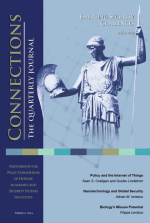The international community has laid down clear red lines about the use of biology to enhance national armaments. Advances in bioscience and biomedicine are, however, significantly eroding technological barriers to acquiring and using biological weapons. This article describes recent scientific trends and analyses their security implications. Three emerging fields of research that have particularly high potential for misuse are considered in more detail: potentially pandemic pathogens, synthetic biology and neurobiology. It is argued that continued efforts are required in multilateral, national and scientific spheres to strengthen the red lines and to foster responsible science.
Biology’s Misuse Potential
Article statistics
Bibliography
"The Biological and Toxin Weapon Trends Symposium." In IAP Global Network of Sci-ence Academies conference., 2015.
"Assessing the Implications of Advances in Science and Technology for the BTW 2016." In IAP Global Security Working Group Meeting. Warsaw, Poland: Polish Academy of Sciences, 2015.
Convergence of Chemistry and Biology: Report of the Scientific Advisory Board’s Temporary Working Group. The Hague: OPCW: Organisation for the Prohibition of Chemical Weapons, 2014.
Life Sciences and Related Fields: Trends Relevant to the Biological Weapons Convention In National Academies Press. Washington, DC: National Research Council, 2011.
"The Biological Weapon Convention Seventh Review Conference." Geneva, 2011.
Lentzos, Filippa. "The Risk of Bioweapons Use: Considering the Evidence Base." BioSocieties 9, no. 1 (2014): 84-93.
Jefferson, Catherine, Filippa Lentzos, and Claire Marris. "Synthetic Biology and Biosecurity: Challenging the ‘Myths’." Frontiers in Public Health 226, no. 115 (2014).
Hunger, Iris, and Filippa Lentzos. "The Future of Biothreat Governance." In Biological Threats in the 21st Century. London: Imperial College Press, 2016.
Council, National Research. Biotechnology Research in an Age of Terrorism. Washington, DC: National Academies Press, 2004.
National Science Advisory Board for Biosecurity. Proposed Framework for the Oversight of Dual-Use Life Sciences Research. Washington: NSABB, 2007.
US Government Policy for Oversight of Life Sciences Dual Use Research of Concern., 2012.
US Government Policy for Institutional Oversight of Life Sciences Dual Use Research of Concern., 2014.
Jackson, Ronald J.. "Expression of Mouse Interleukin-4 by a Recombinant Ectromelia Virus Suppresses Cytolytic Lymphocyte Responses and Overcomes Genetic Resistance to Mousepox." Journal of Virology 75 (2001): 1205-1210.
Wimmer, Eckard. "The Test-tube Synthesis of a Chemical Called Poliovirus. The Simple Synthesis of a Virus Has Far-reaching Societal Implications." The European Molecular Biology Organization Reports – Special Issue 7 (2006): S3-S9.
Tumpey, Terrence M.. "Characterization of the Reconstructed 1918 Spanish Influenza Pandemic Virus." Science 310 (2005): 77-80.
Vogel, Kathleen M.. "Expert Knowledge in Intelligence Assessments: Bird Flu and Bioterrorism." International Security 38 (2014): 39-71.
Harmon, Katherine. What Really Happened in Malta This September When Contagious Bird Flu Was First Announced. Scientific American (blog), 2011.
MacKenzie, Debora. "Five Easy Mutations to Make Bird Flu a Lethal Pandemic." New Scientist (2011).
U.S. Department of Health and Human Services. Press Statement on the NSABB Review of H5N1 Research. NIH News, 2011.
World Health Organization. Technical Consultation on H5N1 Research Issues – Consensus Points ., 2012.
World Health Organization. Public Health, Influenza Experts Agree H5N1 Research Critical but Extend Delay., 2012.
The Royal Academy of Engineering. Synthetic Biology: Scope, Applications and Implications. London: The Royal Academy of Engineering, 2009.
Lentzos, Filippa, Catherine Jefferson, and Claire Marris. "The Myths (and Realities) of Synthetic Bioweapons." The Bulletin of Atomic Scientists (2014).
Gardner, Timothy S.. "Synthetic Biology: From Hype to Impact." Trends in Biotechnology 31, no. 3 (2013): 123-125.
National Science Advisory Board for Biosecurity(NSABB). Addressing Biosecurity Concerns Related to the Synthesis of Select Agents. Bethesda, MD: National Institutes of Health, 2006.
Vogel, Kathleen. "Bioweapons Proliferation: Where Science Studies and Public Policy Collide." Social Studies of Science 36, no. 5 (2006): 676.
Tucker, Jonathan B., and Raymond A. Zilinskas. "The Promise and Perils of Synthetic Biology." The New Atlantis 25 (2006): 38.
US Trends in Synthetic Biology Research Funding. Washington DC: Wilson Center, 2015.
US Department of State. Confidence-Building Measure Return Covering 2014: Convention on the Prohibition of the Development, Production and Stockpiling of Bacteriological (Biological) and Toxin Weapons and on their Destruction., 2015.
Council, National Research. Emerging Cognitive Neuroscience and Related Technologies. Washington, DC: National Academies Press, 2008.
The Royal Society. Neuroscience, Conflict and Security. London: The Royal Society, 2012.
Requarth, Tim. "This is Your Brain. This Is Your Brain as a Weapon." Foreign Policy (2015).
Davison, Neal. Non-Lethal In Weapons. London: Palgrave Macmillan, 2009.
The Human Brain Project: A Report to the European Commission . Lausanne: The HBP-PS Consortium, 2012.
The White House. Fact Sheet: BRAIN Initiative., 2013.
Lentzos, Filippa, and Cecilie Hellestveit. "The Categorical Ban on Bioweapons: Challenged by Synthetic Biology?" In High-Tech War and International Law., 2016.
Cottier, Michael. "War Crimes: Article 5." In Commentary on the Rome Statute of the International Criminal Court, Observers’ Notes, Article by Article, 413. 2nd ed. Oxford: Hart Publishing, 2008.
Wagner, Markus. "The ICC and its Jurisdiction – Myths, Misperceptions and Realities." In Max Planck Yearbook of United Nations Law, 460. Vol. 7. Boston: Brill, 2004.
Cited In
Tagarev, Todor, Nikolai Stoianov, and George Sharkov. Integrative Approach to Understand Vulnerabilities and Enhance the Security of Cyber-Bio-Cognitive-Physical Systems In 18th European Conference on Cyber Warfare and Security, ECCWS 2019. Vol. 2019-July. Coimbra, Portugal: European Conference on Information Warfare and Security, ECCWS, 2019.

